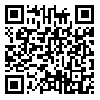BibTeX | RIS | EndNote | Medlars | ProCite | Reference Manager | RefWorks
Send citation to:
URL: http://tumj.tums.ac.ir/article-1-628-en.html
Background: Although it is not a new disorder, in recent times we have attained a greater understanding of auditory neuropathy (AN). In this type of hearing impairment, cochlear hair cells function but AN victims suffer from disordered neural transmission in the auditory pathway. The auditory neuropathy result profile often occurs as a part of that of the generalized neuropathic disorders, indicated in approximately 30-40% of all reported auditory neuropathy/auditory dyssynchrony (AN/AD) cases, with approximately 80% of patients reporting symptom onset over the age of 15 years. In the present report, the results of audiologic tests (behavioral, physiologic and evoked potentials) on two young patients with generalized neuropathy are discussed.
Case report: Two brothers, 26 and 17 years old, presented with speech perception weakness and movement difficulties that started at 12 years of age and progressed as time passed. In their last examination, there was a moderate to severe flat audiogram in the older patient and mild low tone loss in the younger one. The major difficulty of the patients was severe speech perception impairment that was not compatible with their hearing thresholds. Paresthesia, sural muscle contraction and pain, and balance disorder were the first symptoms of the older brother. Now he can only move with crutches and his finger muscle tonicity has decreased remarkably, with marked fatigue after a short period of walking. Increasing movement difficulties were noted in his last visit. Visual neuropathy had been reported in repeated visual system examinations for the older brother, with similar, albeit less severe, symptoms in the younger brother.
In the present study of these patients, behavioral investigations included pure-tone audiometry and speech discrimination scoring. Physiologic studies consisted Transient Evoked Otoacoustic Emission (TEOAE) and acoustic reflexes. Electrophysiologic auditory tests were also performed to determine Auditory Brainstem Response (ABR), Auditory Middle Latency Response (AMLR) and Auditory Late Response (ALR). The results of these examinations for these two siblings are discussed and compared with the results of other studies.
Conclusion: Distinguishing auditory neuropathy from other speech perception disorders can be performed by conducting audiologic evaluations as a battery of tests. The probability of generalized neuropathy must be considered in patients with auditory neuropathy symptoms.
| Rights and permissions | |
 |
This work is licensed under a Creative Commons Attribution-NonCommercial 4.0 International License. |





